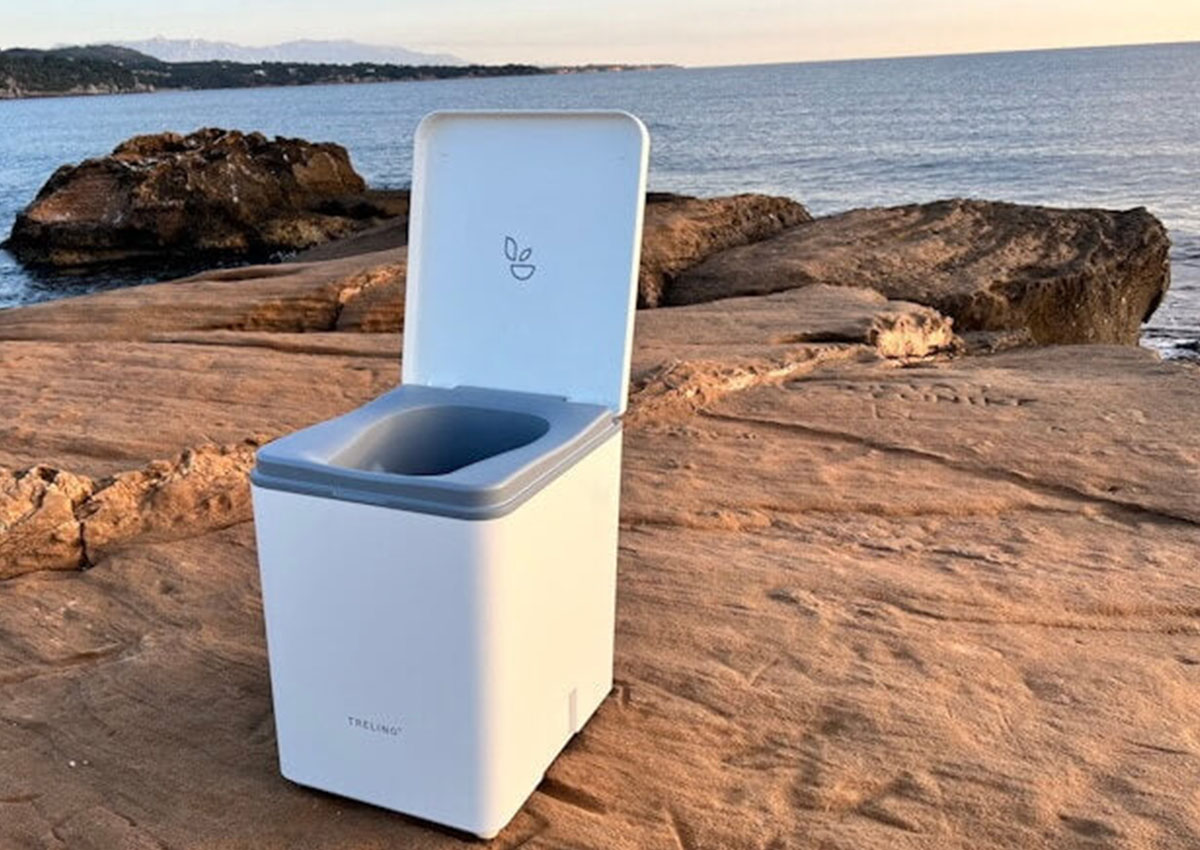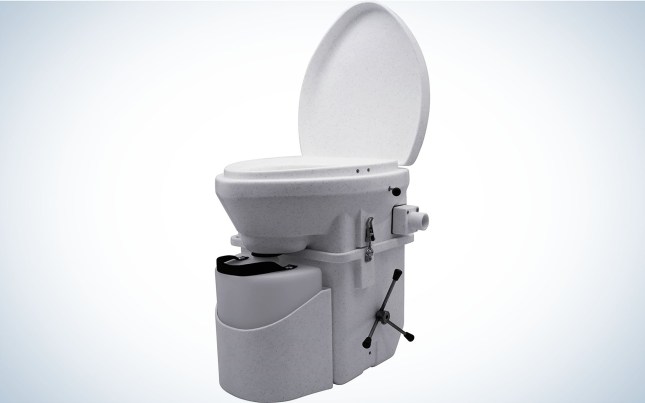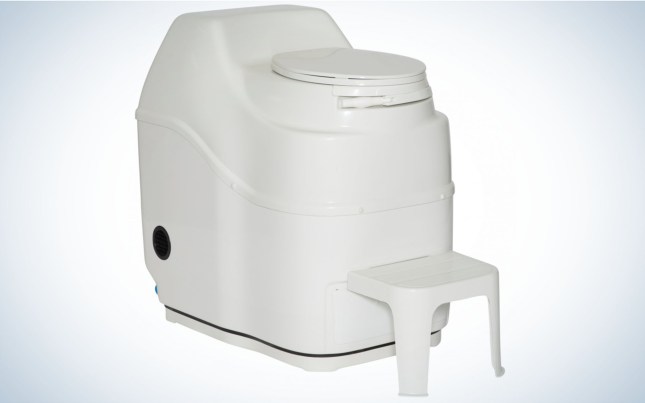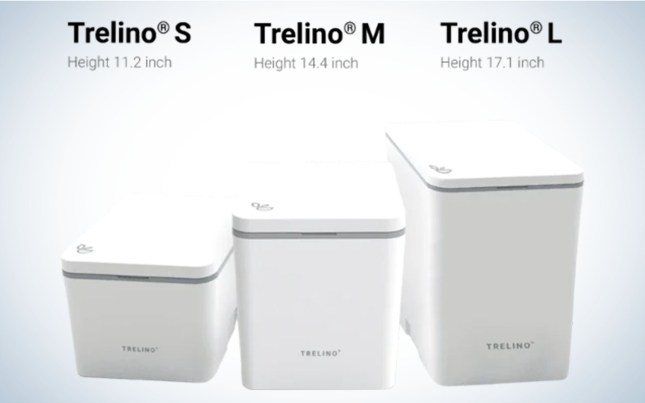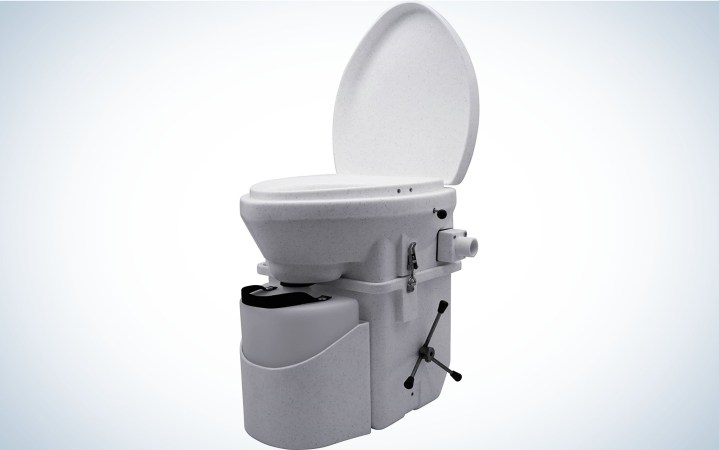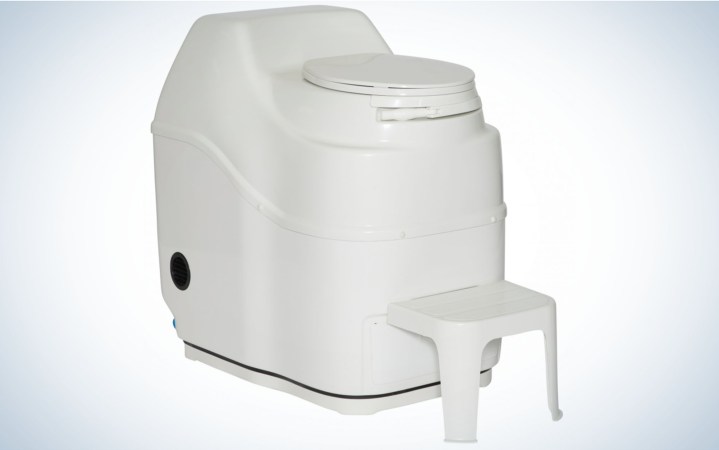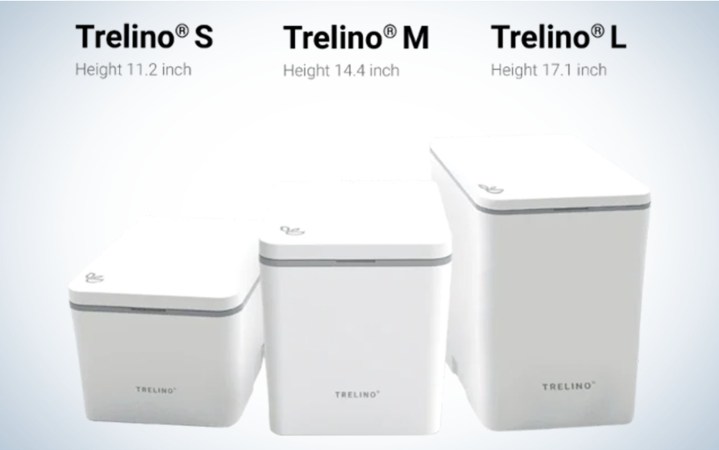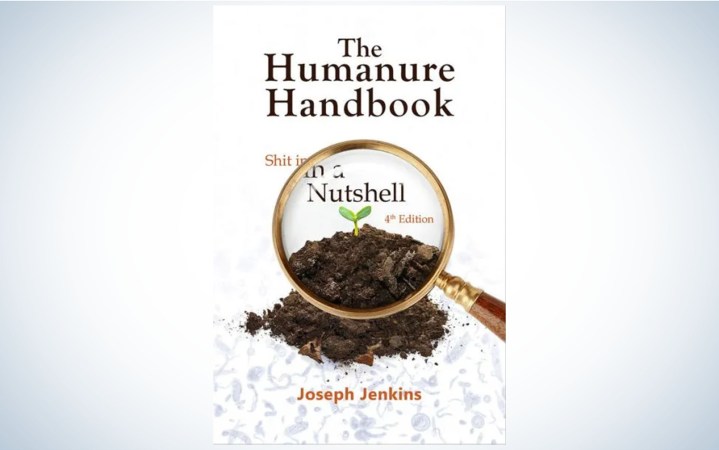We may earn revenue from the products available on this page and participate in affiliate programs. Learn More ›
Approximately 2.5 billion people worldwide and 4 million people in the United States live without a flushing toilet. In Alaska, about 22 percent of the population—just over 160,000 people—live without running water. In fact, in my small community of 800 people, about half live without flush toilets and instead use an outhouse. This means my wife and I venture outside whenever nature calls—even in the winter time, fully donned in parkas.
Composting toilets can solve this dilemma. Some can be used inside for convenience, and it can be better for the environment. Human waste compost has nutrients that can help your garden. For this piece, I looked at a few different models of composting toilets. Some need power; some do not. I talked with people who own and use these different toilets to learn the pros and cons of each one. I personally own the Trelino Evo Composting Toilet, which we use during the winter months. The best composting toilets provide an eco-friendly solution to a lack of indoor plumbing.
- Best Overall: Nature’s Head Composting Toilet
- Best for Home Use: SunMar Excel Composting Toilet
- Best Non-Electric: Trelino Evo Composting Toilet
- Best Budget: The Humanure Handbook
How We Chose the Best Composting Toilets
I live without running water and use an outhouse or my Trelino Evo Composting Toilet. For this piece, I did research on what products were available and compared them to each other. I also surveyed other composting toilet users about their favorite products. A majority of folks I spoke to swore by the SunMar or Nature’s Head brands.
Best Composting Toilets: Reviews & Recommendations
Best Overall: Nature’s Head Composting Toilet
Best Overall
Nature’s Head Composting Toilet
Key Features
- Weight: 28 pounds
- Capacity: 60-80 solid uses
- 19 inches wide x 20 inches tall x 17.75 inches long
- Five-year warranty
- $995
Pros
- Simple set up and installation
- Easy to clean
- No foul odors
Cons
- You can only sit (no standing to pee)
- Have to remove the whole toilet to empty solids
- Needs a power source
Nature’s Head Composting Toilet is a crowd favorite among RVers, boaters, and everyday home owners. This is a waterless toilet that has a separator for liquids and solids. It is designed for up to four people and if you were using it on a full-time basis, you would need to empty it every two weeks to a month (60-80 solid uses). The liquid container holds 2.2 gallons and should be emptied every two to four days, depending on use. There is a trap door that you maneuver to direct liquids or solids to their specific container. Before using the solid bin you need to add a composting material like peat moss or coconut fiber. This allows better breakdown. You can put your toilet paper in the solid bin, but it does take longer to break down than your waste. This model does require a venting fan (included) that draws 1.7 amps per day, and is anticipated to cost about 4 cents per month.
Although it is easy to clean, you do need to remove the whole toilet to empty the solids, as the model does not have a drawer to pull out to empty. You can empty the solids into a 13-gallon garbage bag.
There is no liftable toilet seat, but rather the seat is attached to the base making it sturdier, easier to clean and unbreakable. That being said, this toilet is best for sitting only, even for men.
Sherry Wykes of Northwestern Ontario has owned and used a Nature’s Head Composting Toilet for more than 5 years and loves it. She has replaced the main gasket as well as the fan, and her only gripe is that the location of the turn crank to mix the solids with the moss is on the bottom side of the toilet and is hard to reach.
Best for Home Use: SunMar Excel Composting Toilet
Best for Home Use
SunMar Excel Composting Toilet
Key Features
- Weight: 60 pounds
- Capacity: Empty every four months
- 36 inches x 28 inches x 36 inches
- Comes in two colors (bone and white)
- $1,965
Pros
- Has a heater and fan
- No separation of liquids and solids
- You can stand or sit
- Needs emptying a few times per year
Cons
- Needs a power source
- Expensive
This is as close as you are going to get to a normal flush toilet, although it uses no water. With a larger capacity and the ability to mix solids and liquids with a heating element, it is ideal for home use and multiple people as it does not need to be emptied often. The SunMar Excel Composting Toilet has no separator, so you use it just like a traditional toilet and mix the solids and liquids. All you need to do is use the rotating arm that extends from the base to turn the drum about every other day. It is stationary, so all you need to do is empty the compost drawer below the seat anywhere from once to every other month per year depending on use.
This toilet uses power for a fan and heater. The heater—along with added composting medium, like peat moss or coconut core—adds in faster decomposition than a model with only a fan or no fan at all. It does have an emergency drain in the rear in case excess liquids need to be emptied.
The ding is obviously the high price, but I spoke with Nate who has been using SunMar toilets for five years on his yurt property in Hawaii and claims the cost is worth every penny.
Best Non-Electric: Trelino Evo Composting Toilet
Best Non-Electric
Trelino Evo Composting Toilet
Key Features
- No electricity needed
- Comes in three sizes
- Weight 8.6 pounds to 10.8 pounds (empty)
- Capacity: 1.1-2.6 gallons of liquid and 1.6-2.6 gallons of solids
- $350-550
Pros
- Separator for liquids and solids
- Soft-closing lid
- Comes with spare lid for liquid bottle and 10 compostable bags
Cons
- Not best for large groups or families
- Composting process does not occur in the toilet
This is a lightweight and sleek design that is easy to empty, clean, and move. The Trelino Evo Composting Toilet is perfect for home, a van, boat, or even at camp. It is intuitive to set up and very light and easy to move as a whole unit. My wife and I personally own one for our dry cabin, and it is small enough to fit, easy to clean and empty, and aesthetically looks very nice. It really doesn’t look like a toilet but rather a white box.
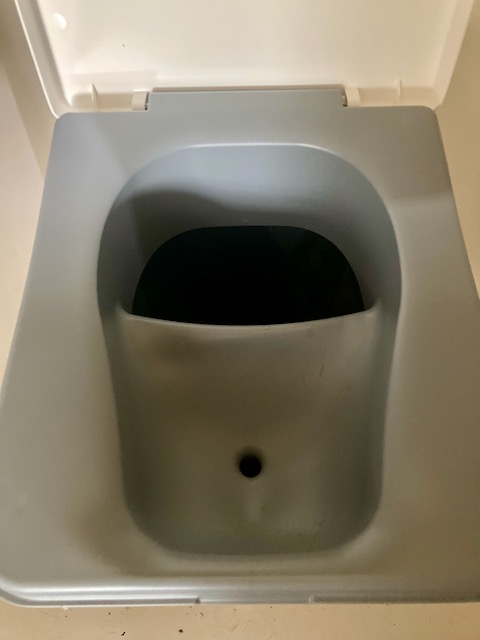
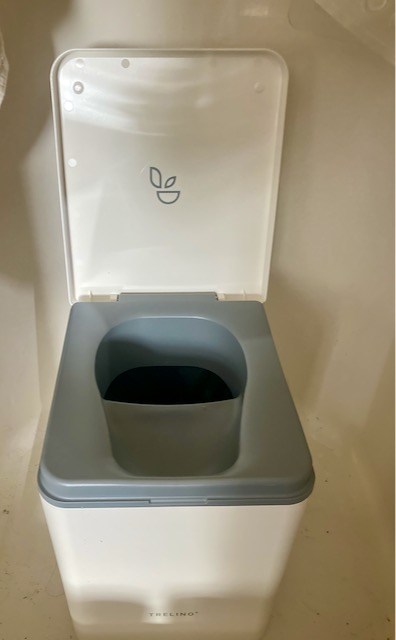
There is a separate canister for liquids and solids, and the liquid canister is leak proof. The solid canister is like a small garbage bin and you put your composting bag in there. We empty the liquids every five days and the solids about once a week.
You do add a layer of composting medium, however it doesn’t break down the solids. As long as you use compostable toilet paper or place it in another container, you can add the bag of solids to your compost. The solid bin comes with a lid if you need to secure it while traveling, but it is not necessary as the lid of the toilet stays on very tightly.
Best for Budget: The Humanure Handbook
Best for Budget
The Humanure Handbook
Key Features
- Detailed explanation of composting
- Learn how to make your own composting toilet
- Free (instructions online) or $25 for paperback
Pros
- Versatile construction for personal needs
- Inexpensive
- No electricity needed to function
Cons
- Manual labor and time
- More work to compost
The do-it-yourself method offers easy-to-follow instructions to build your own composting toilet with minimal costs. This paperback book ($25) or online instructions (free) teach you how to build and maintain a composting toilet. The cost is however much you put into the materials. For example, you can use supplies that you already have on hand for a simple box toilet you can use indoors. Or you can go as far as creating an outhouse with a roof and walls surrounding the actual toilet.
The toilet collects liquids and solids together, but if you want that to compost, you need to do some more work beyond building the toilet. It wouldn’t not need any electricity or mixing/stirring to compost, but you would need to add an organic composting medium, like sawdust, straw, or peat moss, after each use to enhance breakdown. The word “humanure” is “human manure,” meaning the fecal matter and urine can be recycled into soil. The capacity could be whatever you build, but you would need to empty and mix the toilet material into another compost bin when it’s full in order to continue the breakdown. Proper composting needs a few other environmental factors, like warmth, so this is why a DIY composting toilet wouldn’t work in a place like where I live in Alaska.
Things to Consider When Buying One of the Best Composting Toilets
Comfort
Make sure the toilet is comfortable with an appropriate height for you. The last thing you want is to be feeling uncomfortable while sitting on the throne.
Cleaning
All the toilets require some sort of emptying or cleaning, so you have to decide what you are willing to put into that process. Where are you emptying it? Can you reach all the parts to clean it without taking it apart? Are there many components to clean? Do the parts separate easily if need be? Will it spill or splash on you while cleaning? Does it have seal-proof caps to keep the liquids in while transporting?
Construction
Whether it is one of the more expensive versions or a do-it-yourself wooden one, there are many questions to consider. Is it durable? Do you need tools to install? Will it get damaged if it lets in the elements (sun, cold, rain) or if you move it? The toilet seat and lid need to be sturdy for daily use but also easily removed for cleaning.
Transporting
If you need to transport it, you’ll want to make sure it is easy to move and disassemble. If you need to move it, can you do it alone or do you need help? Does it have handles to transport it?
Rotation
Some toilets require more work than others for the composting to take place. Do you need to rotate the composting material and your solids? Is it easy to access the rotating handle? Does this handle interfere with you when you are sitting down? Is it easy to rotate on your own?
Smells
The last thing you want is a stinky toilet, and most composting toilets attempt to keep the smell inside. One feature that helps with that are secure seals to keep the smells in.
FAQs
Toilet paper is technically paper, which is from a tree, so in theory, yes you can put toilet paper in your composting toilet. It is best to use recycled, RV-specific or one-ply toilet paper. It does take longer to break down than your solids. You want to make sure you always put it in the solid compartment. If you can separate it and throw it away, you will have more room in the solids bin for human waste.
Some toilets, like the SunMar Excel Composting Toilet, have a drawer that you can pull out and empty the compost. Others, like the Nature’s Head Composting Toilet, you’ll need to remove the toilet to empty. Some, such as the Trelino Evo Composting Toilet, utilize a bucket in the base that you can remove and empty. Just make sure you do your research before buying your toilet.
The compost process all depends on how often you use the toilet, how many people are using the same toilet, and what kind of heat or fan source you have. It also depends on what kind of composting material you add to your solids. The composting starts to work immediately after you do your business, but time, temperature, and conditions will determine when you are ready to use your compost.
Final Thoughts on the Best Composting Toilets
Not everyone has the luxury of plumbing, running water, or flush toilets. The best composting toilets can be an ideal and eco-friendly solution. Instead of having to find a place for waste, composting allows you to safely return it to the environment.
